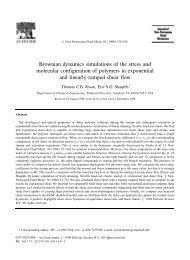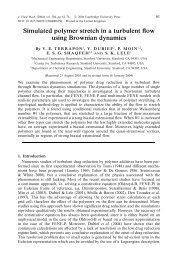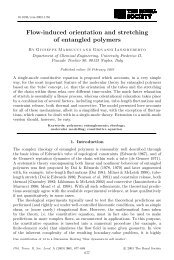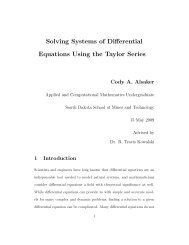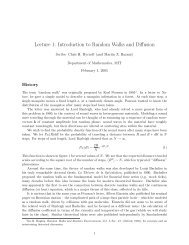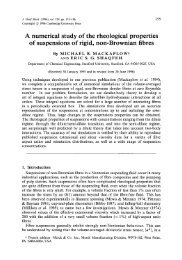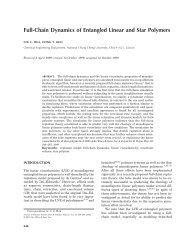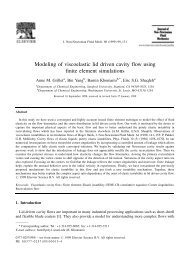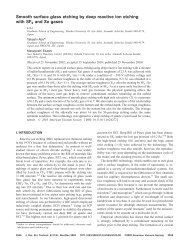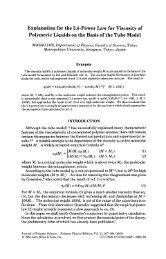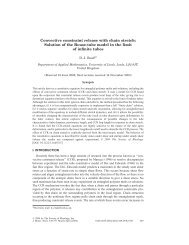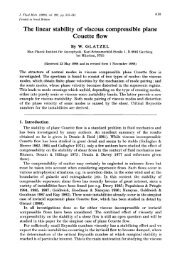Molecular modelling of entangled polymer fluids under flow The ...
Molecular modelling of entangled polymer fluids under flow The ...
Molecular modelling of entangled polymer fluids under flow The ...
Create successful ePaper yourself
Turn your PDF publications into a flip-book with our unique Google optimized e-Paper software.
3.2. SINGLE MODE POM-POM MODEL 53<br />
At constant α, decreasing τ b shifts the S xy curve to the right but does not alter its<br />
shape since at lower orientation times it takes longer for the shear rate to reach a<br />
sufficient size to orientate the backbone. Decreasing α broadens the curve because the<br />
time interval between beginning orientation to completely orientating the backbone is<br />
dilated. For intermediate relaxation times, where α ∼ 1/τ b , the solution is complicated<br />
by the discontinuity in shear rate at t=0. This is observed in the rapid rise in degree<br />
<strong>of</strong> orientation at early times followed by a shallowing <strong>of</strong> the gradient as the effect <strong>of</strong><br />
reptation becomes significant seen most clearly in the τ b = 0.1sec curve. <strong>The</strong> main<br />
difference in behaviour <strong>of</strong> S xy between simple and exponential shear is that in the<br />
exponential case the rising shear rate will always become large enough to orientate the<br />
backbone sections and to cause S xy to tend to zero at long times regardless <strong>of</strong> how<br />
small the backbone orientation time is.<br />
In planar extension with a velocity field v x = ˙ɛx, v y = −˙ɛy and v z = 0, <strong>The</strong> rate<br />
at which the <strong>flow</strong> stretches the backbone segments is ˙ɛ(S xx − S yy ). Figure 3.3 shows<br />
the solutions to the pom-pom equations for orientation difference, S xx − S yy , in planar<br />
extension. For ˙ɛ > 1/2τ b the backbone sections become fully aligned along the direction<br />
1<br />
0.8<br />
0.6<br />
S xx - S yy<br />
0.4<br />
0.2<br />
τ b<br />
[sec]<br />
0.03<br />
0.1<br />
0.3<br />
0.4<br />
1.0<br />
3.0<br />
0<br />
0 2 4 6 8<br />
time [sec]<br />
Figure 3.3: Evolution <strong>of</strong> S xx − S yy for a planar extensional <strong>flow</strong>, ˙ɛ = 1sec −1 .<br />
<strong>of</strong> extension so that S xx − S yy approaches 1 at large times. For ˙ɛ < 1/2τ b the strain<br />
rate is not sufficiently fast to align the backbones fully before they relax. <strong>The</strong> plateau<br />
value <strong>of</strong> S xx − S yy falls with decreasing orientation time. Rapidly reptating backbones<br />
hardly orientate at all in slow <strong>flow</strong>s.<br />
Figure 3.4 shows the predicted behaviour <strong>of</strong> S xx − S yy in exponential shear. When<br />
α > 1/τ b the deformation is essentially affine. <strong>The</strong> resulting curves have some similarities<br />
with those <strong>of</strong> planar extension. As is the case with extensional <strong>flow</strong>s the molecular<br />
segments align parallel to the x-axis. For α < 1/τ b the initial shear rate is too small to



